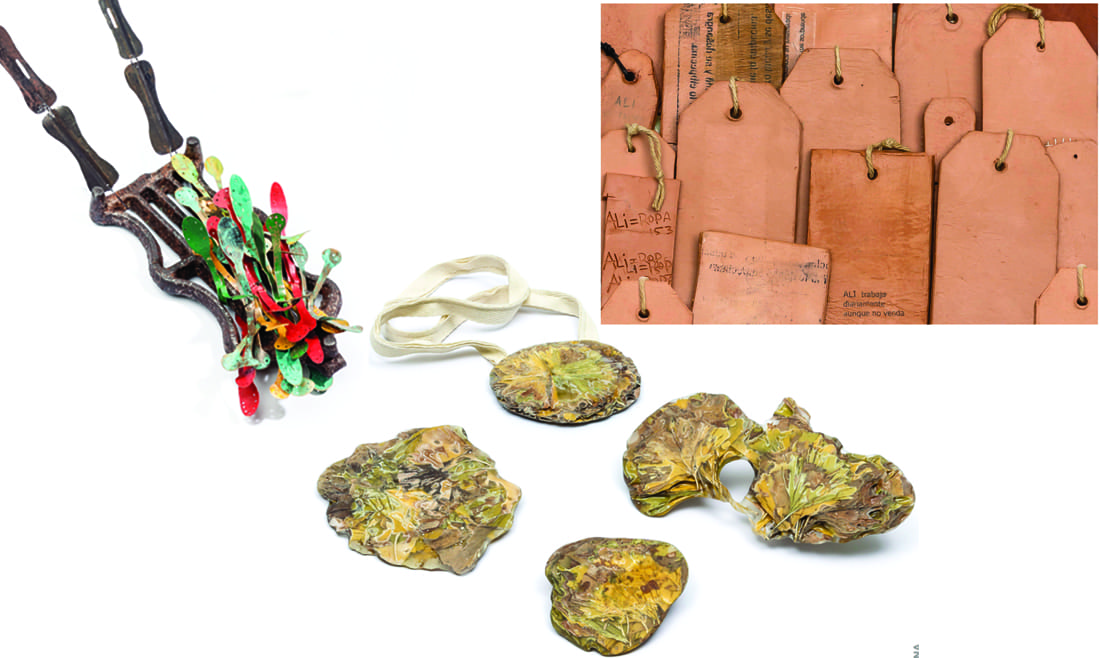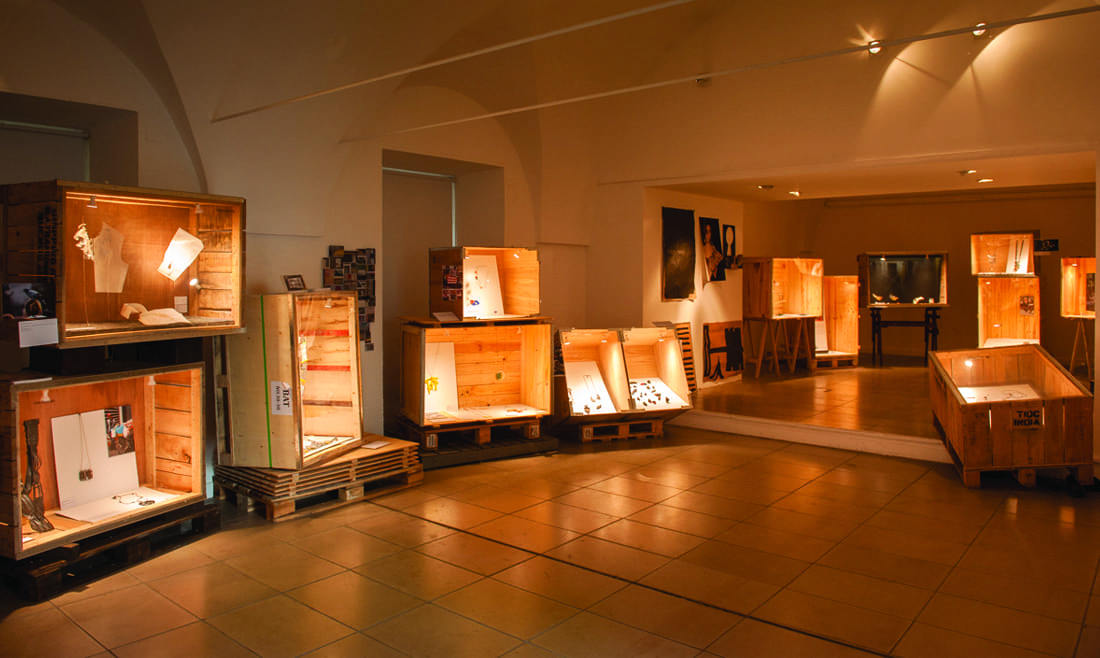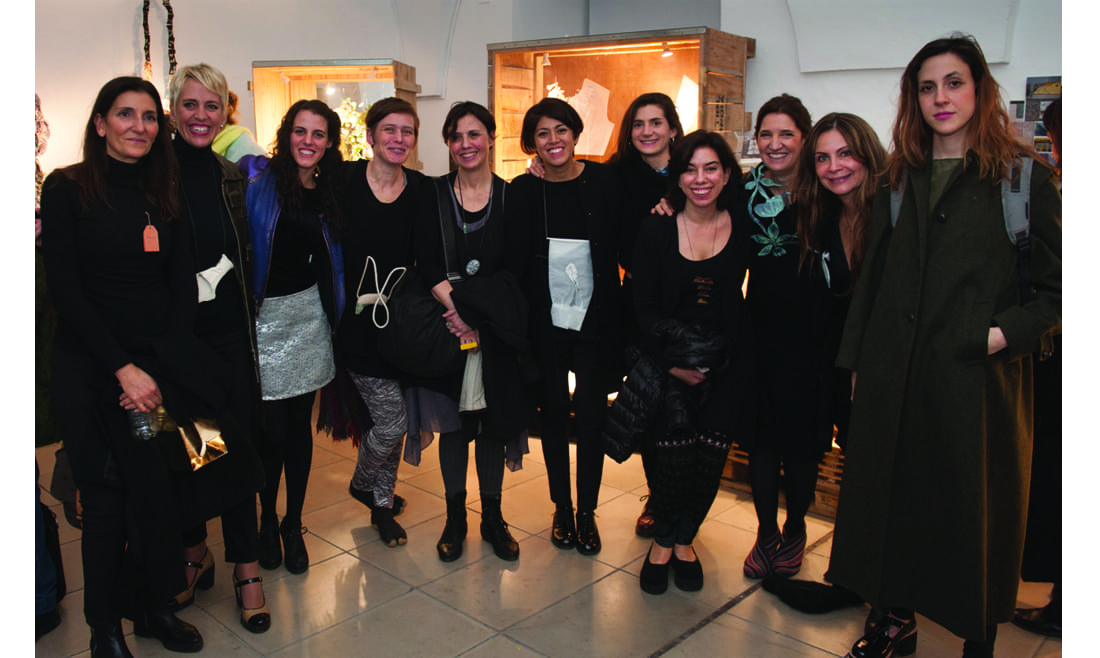Lo inesperado de lo cotidiano (The unexpected of the quotidian) is the name of an exhibition that took place from June 23 to July 31 in the Recoleta Cultural Centre in Buenos Aires City. The exposition showed more than fifty contemporary jewelry pieces which were made by eighteen Argentinean and Mexican female artists. All of them worked under the concept of unexpected situations that have place in our urban daily routine. Moreover, non-conventional techniques and materials were mixed with traditional ones in order to create a new language to express the idea previously mentioned. As a result, each artist shows a different view on the theme, elaborating a fresh perspective and a re-signification of objects.
Francisca Kweitel, a clothing designer and jeweler from Argentina, and Mayte Amezcua, a graphic designer, artist and jeweler from Mexico, were in charge of management and coordination to give life to this fascinating event. Kweitel explained that the idea of a joint exhibition came up during the second edition of En Construcción (In Construction), a contemporary jewelry symposium, in September of 2015. “The first one was held in Buenos Aires and then took place for the second time in the magical city of Valparaíso, in Chile. The event is carried out every three years, gathering Latin-American jewelers to experience a week of workshops, lectures and exhibits of this discipline,” she added. “Mayte Amezcua was invited to organise a showing for the second edition and she managed, with her group of artists, Lo inesperado de lo cotidiano in Valparaíso. Once I was back in Buenos Aires, I suggested Mayte to turn this already established exhibition into an itinerant one, traveling to each host country. So, we started working on our first shared version between Mexico and Argentina.”
Afterwards, it was the moment to step up and get down to business. Kweitel decided to assemble a group of local artists with the same number of participants as the Mexican show, who shared the enthusiasm and had the possibility to meet regularly to work, debate, collaborate and exchange views on the theme as a team. She declared that “this group also had to be made up of strong personalities with their own developments, which should be diverse, in order to widen and enrichen their sights, taking into consideration the variety of concepts, thoughts, materials and working methods of each artist.”
Despite the fact that not all of the nine female artists knew each other already, they got on well from the start. This came as a surprise for Kweitel: “Such a fluid bond was immediately generated that I stepped out of the organisation centre to let them work. We had a few encounters as a follow up of the projects and to share each development in an ordered manner with the contribution of the entire group. Finally, I accompanied the group tangentially, helping to make a decision when someone was getting entangled with an idea or when silence was just the thing they needed. They managed, organised, put on the exhibit and work in its promotion. It was an enormous learning process for someone who is not used to doing these tasks.”
Regarding the future of Lo inesperado de lo cotidiano, Kweitel commented: “To tell the truth, the idea to turn this show into an itinerant one began with my suggestion to Mayte based on what she had already concerted. Now, each party should decide whether they want to keep on this common path, travelling around the world and making this exhibit grow with each host country that wants to join the experience. I have already suggested the idea to some people in Chile, Brazil and Colombia, to join this marvellous encounter!”
A voyage to the (un)known
It was a cold but sunny afternoon in Buenos Aires, and the Recoleta Cultural Centre was a bit crowded with families and children, due to the winter school break. I walked down its aisle and went into Room 11 to be welcomed by warm light and the exhibit’s manifesto:
To walk with a sharp sight, a new sight, a typical sight of a place, of a journey.
How can small movements surprise us so much?
Which sensation or reflection is awakening inside ourselves when we meet beautiful corners or unnoticed objects?
All that it takes is to slow down, to go slowly and to widen or sharpen up the gaze.
We tell it from within the body, from within the objects that travel on it.
These pieces are the ones that will give sense to the exhibit where eighteen jewelers from Argentina and Mexico display the results of focusing on the vertiginous movement possessed by our cities.
At first glimpse, you could see the itinerant spirit of the exhibit: shipping wooden boxes harboured the jewelry pieces, which were illuminated from within and situated around the room. Mexican and Argentinean artists’ boxes were mixed, creating parallels between their cities. In most cases, a picture, a text and the artwork formed an ensemble that allowed the spectator to enter the scene proposed by the jeweler.
Then, I met Lucía Mishquila Brichta and Sandra Tamborini, two of the local artists, who kindly became my guides. “The setting up of the exhibition was part of a necessity of putting each artwork in relation with each other, being very different around the same theme,” clarified Brichta. Tamborini explained: “We focused on the urban. You may consider the quotidian as an intimate space of everyday life, but the idea was to take this to the outside, to whatever happens in our experience in the city. Each of us was affected or wanted to take a certain situation as focal point.”
Furthermore, it felt as if the displayed objects had been brought to life and were eager to tell a story, making the public an active part of the show, interpreting its meaning and finding a piece of these cities reflected in them. Just as Brichta said, “Contemporary art implies a commitment from the person that is looking at the artwork. This is something much more abstract. You have to willingly stop in front of it, feel it and register it. Contemporary Jewelry has to do with the re-signification of jewels, of giving value and identity to the object. There are a lot of ways to do so.”
Besides, contemporary jewelry, as a rare amalgam of art, design and craftsmanship, is still an emerging discipline in the region. “This category is relatively new in Latin America, although it has a full trajectory in Europe. There is an increasing group of contemporary jewelers that tries to expand this movement to places that show interest in this,” commented Brichta. Then, Tamborini detailed, “The fact that a contemporary jewelry exhibition was inserted in this museum in Argentina is a breakthrough. This situation is already a common practice in other countries.” Finally, Brichta resumed, “It is truly important for us to be able to show our pieces here, in a busy place that is visited by a large audience, formed by people of different ages and backgrounds, and to share the space with other disciplines.”
Eventually, we took a stroll around the room, while talking about the pieces and artists involved in this project. Only for order sake, the following recap of jewelers and their work will be organised by country, commenting on Mexicans first, as they have given origin to this journey.
Mayte Amezcua, who also managed the first exhibition, takes the supermarket trolley as an international icon. However, she takes into consideration how it turns into a mobile store in Mexico, and that has a certain decoration that functions as disguise. “Each of these vehicles is transformed into an unexpected place the people go to and where they satisfy their daily needs.” Thus, Amezcua presented a brooch, a necklace and a ring that copies the trolley’s structure, adorned with pieces of tablecloth and plastic rope.
Elvira Bessudo considers windows in México DF as the start of a constant dialogue established with passers-by. “It surprises and amuses us many times, but it can also become totally unperceived.” As a result, Bessudo created a necklace and two pendants with iron and acrylic, imitating the window’s bars and what you might find behind them.
In México City, as in any other metropolis, parking spaces are precious areas for its inhabitants. Raquel Bessudo tried to emphasise the Mexican’s inventiveness and resources when it comes to reserving a space. She was witness to the transformation of objects given this new task: a dressed plastic chair in front of a fabric store, a container with grass growing inside of it, or a wooden chair, deprived of fulfilling its duty. Consequently, Bessudo’s necklaces are a simplified reflection of these multifaceted articles.
Enlarge
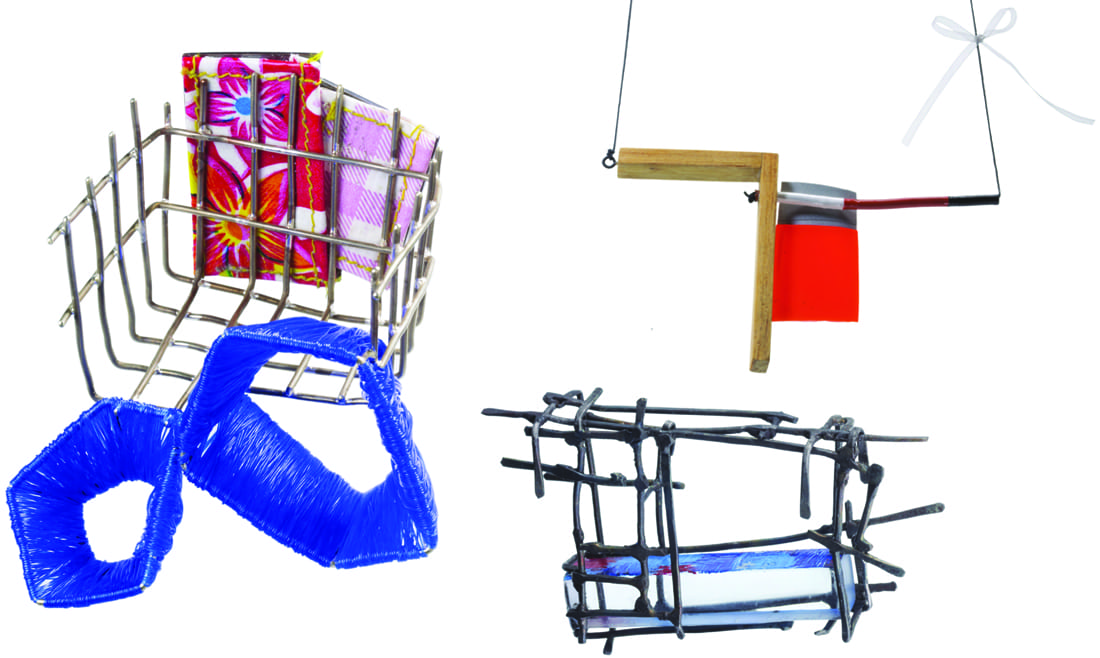
Centro Cultural Recoleta / Francisca Kweitel
Sandra Bostock’s work was inspired by the chaotic network of wires and how it can be shocking at first glance but assimilated when we take the time to observe it. “Chaos has order and beauty. The use of materials that resist the urban background with a function gives a jewelry piece a different appearance, artistic at the same time”. Accordingly, her pieces (two necklaces and three brooches) are mainly made with circular webs of electric wires and little boxes.
Lorena Lazard visualises Mexico City as a place where past and present meets and fuse together, creating a new reality. Therefore, her creations (a brooch and two pendants) show both old and modern maps of the capital transferred in polymer clay and framed with iron.
Carol Neumann focuses on the figure of street taqueros, those who sell tacos from their bicycles. Neumann points out that the increase of unemployment has given birth to alternative activities such as this one. “Bicycles are loaded with a basket full of tacos, as well as all tools and condiments needed for its making and consuming”. She deconstructs the bike to generate three necklaces out of its parts.
Enlarge
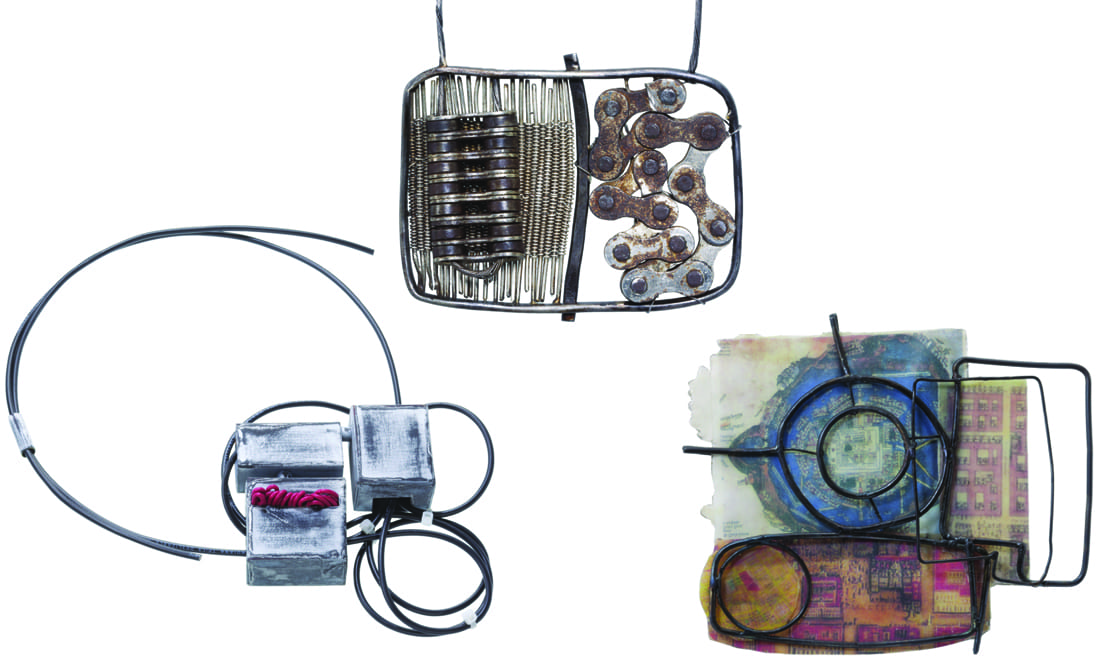
Centro Cultural Recoleta / Francisca Kweitel
Jackie Roffe wanted to capture the moment when young people play making bubbles and these reflect images in Chapultepec Park. The bubbles “are my favourites because, when you see through them, you perceive how fantastic and unexpected worlds are encapsulated for a few seconds. They allow us to watch the exaggeration of the ephemeral”. The whimsical ring and necklaces displayed tiny figures encapsulated in glass spheres with magnifying glass.
Laura Elena Sánchez’s work is centred in Esteban Trejo, a man who lost one leg and survives through an old trade, knitting with bejuco, repairing old chairs and tables. He sits on the street of a resident area and works every day. “Working in one of the oldest trades, Don Esteban contrasts in front of modernity and the surrounding’s wealth”. A brooch and two necklaces appear as symbols of this story, through Trejo’s small seat and his knitting skills.
Heavers, people that carry goods around the historic district in trolleys, caught Martacarmela Sotelo’s attention. They mobilise extremely heavy loads through the place using any mean at their disposal. “To make their journeys they turn to ropes, boxes, cardboards, bags and sackcloth”. For this reason, her necklaces are composed of an intricate weave of nickel silver and rope.
Enlarge
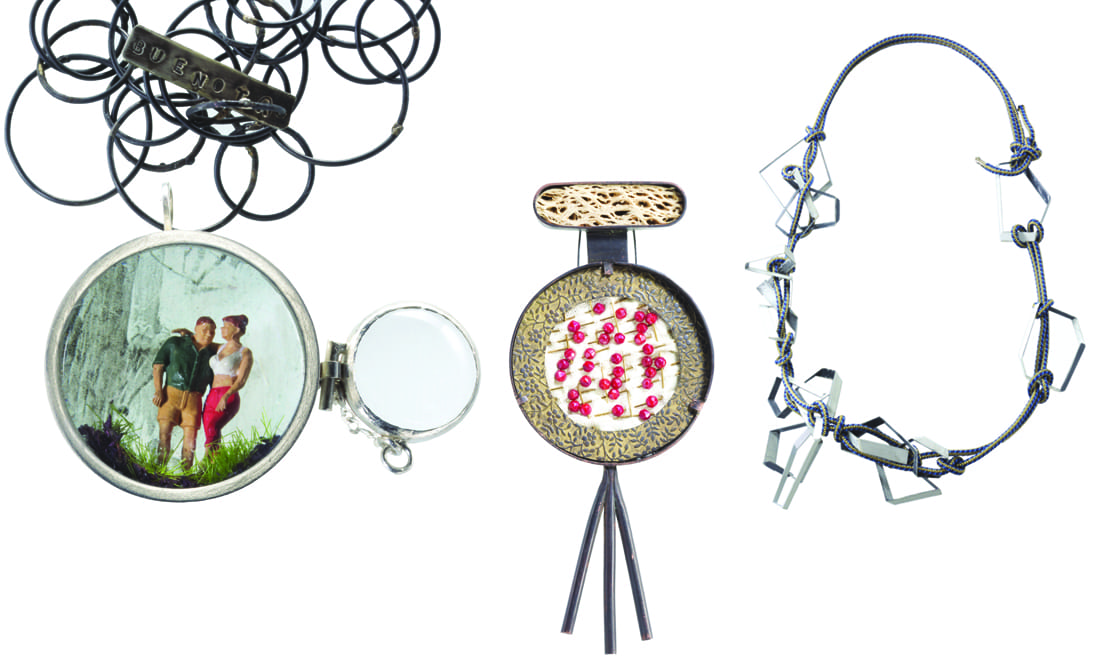
Centro Cultural Recoleta / Francisca Kweitel
Like many cities, Buenos Aires is the home of a large population of pigeons. This can lead to unfortunate consequences for the people who pace around under these birds. Carolina Bernachea captures poetically that moment when you unexpectedly get stained. “Anonymous mark left on its flight, that prints indiscreetly the beauty of my blue silk dress. Confusion, laughs, phobia… Good luck! Good luck!, it is said”. Her jewels are made of parts of a white shirt created with silken paper and other elements that evokes the unfortunate “missile”, such as acrylic, silver and stainless steel.
Lucía Mishquila Brichta’s brooches were inspired by the small gestures you would be able to catch while riding the bus through the city. “Traveling time thus becomes a cohabitation space where there’s people that read, that have conversations over the cell phone, that put make-up on, that play, that talk to each other, that kiss”. She started writing in a new notebook on the 1st of January, searching for a theme, observing unexpected situations and reading books that talked about cities. “Simultaneously I worked intuitively with rubber, on the go. I have been working with this material for a few years now. It comes from the tyres of rural vehicles, so it is really thick. I assemble and carve it into jewelry pieces. The moment came when I had to choose a theme for my participation and finally, I linked two situations. Firstly, having realised that I have the habit of creating small gestures. The pieces created by me are small. Secondly, I wrote a text about gestures of people when they are riding the bus. This is a collective and quotidian situation: we share a limited space for a few seconds or minutes with people we won’t see anymore. Nevertheless, it is a shared instant”.
Cecilia Capisano has chosen the announcement of the rebuilding of a traditional pastry shop, bar and restaurant called Confitería del Molino, which has been abandoned for over twenty years. “This project invites to a toast using fragments of the epoch’s crystalware to celebrate this event”. In fact, this artist presented a collection of necklaces, brooches and rings made with resin and cement, which simulated the glass-ware.
Enlarge
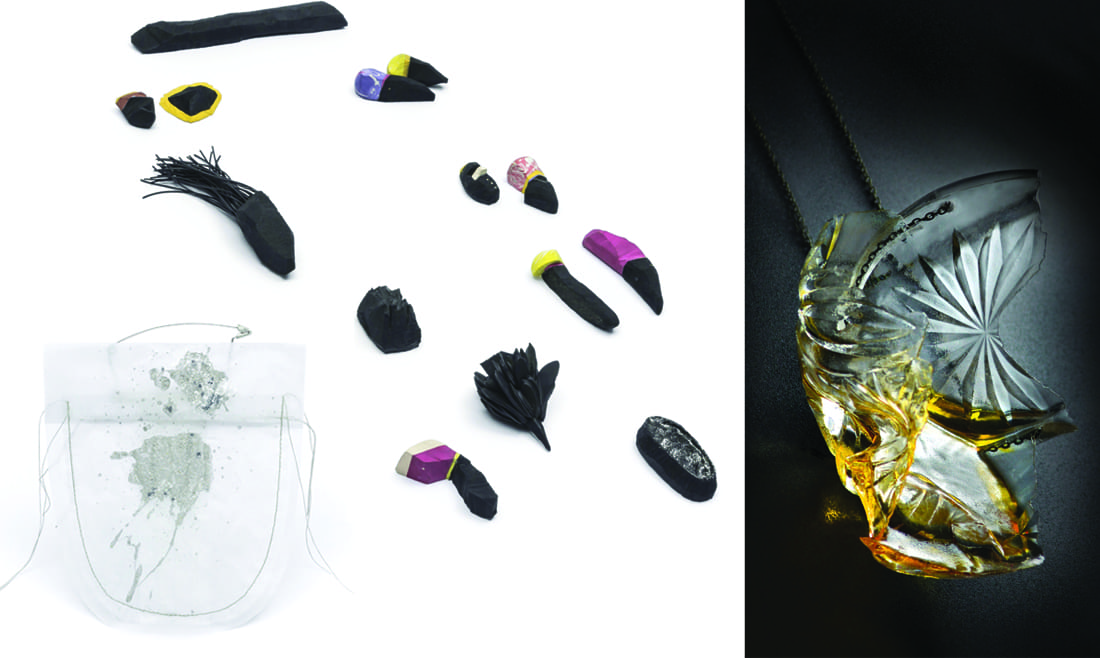
Centro Cultural Recoleta / Francisca Kweitel
During the last summer, Buenos Aires experienced the invasion of camalotes in the Río de la Plata. As a result of floods and a rise in the northern river basin, this vegetation arrived at the city, bringing animal species that usually live on it: snakes, insects and otters. “An island that moves / that bring things / and that in its route / hooks and gets hooked with others”. Mercedes Castro Corbat created enormous necklaces that recreated these green invaders in painted fabrics. A curious fact is that the jeweler also used posters from a prevention campaign against dengue fever, which was another important issue on last summer’s local agenda.
“…a door has a small hole. As big as the daily nature of entering always to the same house, is the fact of spying on it once…”. This is the phrase that accompanied Ana Hirsch’s artwork. She introduced a symbolic and ludic relation between the eye, the key and the keyhole. Her necklaces were made in cardboard and decorated with acrylic, resin and Argentine coins.
Laura Leyt focuses on the difference in the city’s pavements, which could be seen as a collage material. “Slowly and patiently I walk and I frame: the city is a grand outdoor art gallery of geometric paintings”. She created a series of rings, brooches and a necklace using recycled plastic to make her own collage of textures and colours within each piece.
Micaela Mornaghi’s starting point was the unexpected change of temperature followed by the sudden fall of tree leaves in the middle of summer. “Strange weather / suspended wind / dried colour dizziness / I feel disoriented, it’s hot, it’s cold / they fall, leave a mark / the heat comes back, the fossilised cold comes back”. Her necklace and brooches were created with ginkgo biloba’s leaves, resin, bronze, stainless steel and cotton ribbons. At first sight each of the jewels had the aspect of a fossil, a leaf that had fallen from the tree and become petrified only to capture this unusual event.
Enlarge
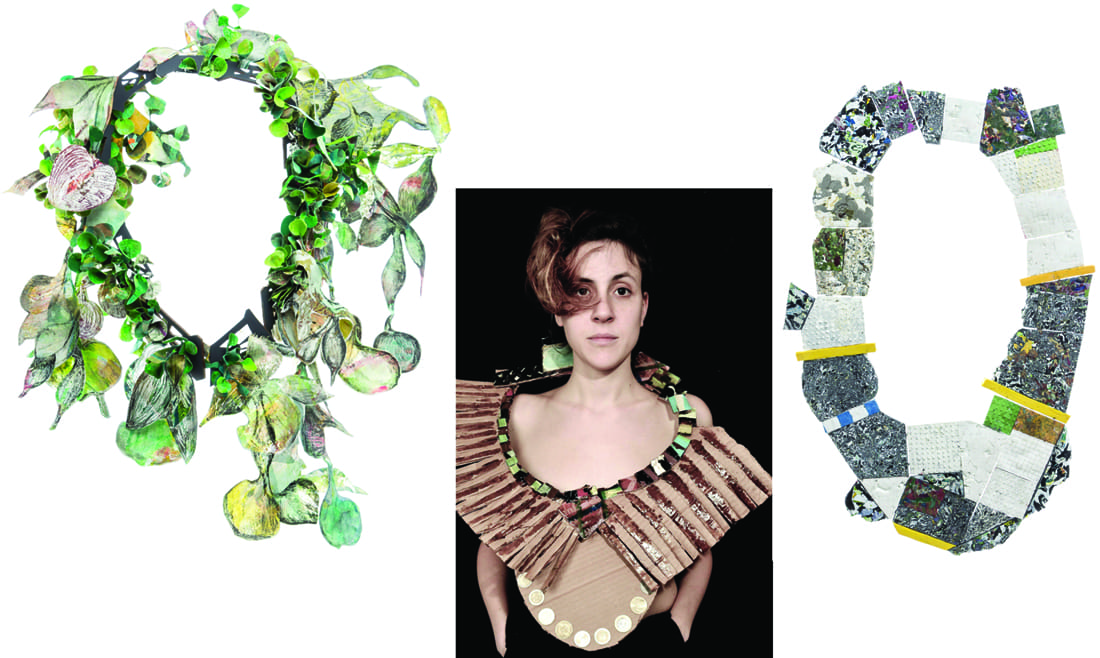
Centro Cultural Recoleta / Francisca Kweitel
Sandra Tamborini wrote a text as a trigger: “In this major city… can the unexpected of the quotidian be the void of the absence? In what instant does the absence of others surprises me and reveals how important it is for me their presence? How do I let it affect me, this presence-absence of another? Can the void generate bonds? And this space, his space, full of his nothingness, condenses the aura of the presence-absence.” She analyses the presence of people that we might not notice in places, which you could consider as empty. Specifically, she made a series of actions in a public space that had been occupied by Ali, a street vendor from Bangladesh in Nuñez, near where the artist lives. He suddenly disappeared, leaving a contact telephone written on the wall, and Tamborini analyses the bonds he have left behind without noticing. She made an installation in that place, which was filmed and showed in the room, alongside with testimonies from other people who knew Ali. “(My artwork) is composed of these elements: the experience of what happened, the installation and its video record, and the installation of the backed clay brooches, recalling the hang-tags of clothes.”
Finally, Ana Weisz took the image formed by the rubbish that gathers on the sewage covers as theme. “The ceremony is carried out in the depths…From time to time in the surface is revealed an ephemeral landscape, a fragment from the ritual.” Consequently, her pieces, a pair of necklaces, were handcrafted in a rusty-looking metal that clashes with the multicolour pieces that mimic the garbage.
By the time I ended the circuit of shipping boxes, it felt as if I had completed a journey through these two wonderful cities. Furthermore, it seemed that I had been accompanied by people that showed me the little things that a mere tourist might have missed or simply passed by. I believe this was the concept behind Lo inesperado de lo cotidiano: not to lose the ability to be amazed by the small features and surprises that surround us in everyday life.

